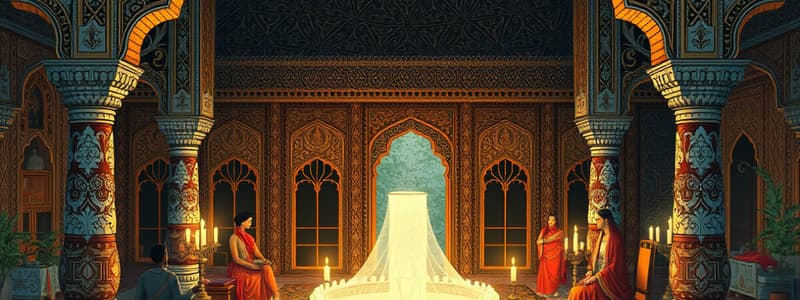Podcast
Questions and Answers
What material is the famous 'Dancing Girl' statue made from?
What material is the famous 'Dancing Girl' statue made from?
- Stone
- Bronze (correct)
- Wood
- Terracotta
What unique feature distinguishes the pottery of the Indus Valley Civilization?
What unique feature distinguishes the pottery of the Indus Valley Civilization?
- Painted with geometric patterns (correct)
- Use of only natural colors
- Exclusively made of terracotta
- Production in massive scale without artistry
Which of the following best describes the urban planning of Indus Valley cities?
Which of the following best describes the urban planning of Indus Valley cities?
- Concentrated around rivers only
- Circular layouts with narrow streets
- Complex layouts with grid patterns (correct)
- Chaotic and unorganized
What type of seals were commonly used in the Indus Valley Civilization?
What type of seals were commonly used in the Indus Valley Civilization?
What indicates the centralized storage and distribution in the Indus Valley Civilization?
What indicates the centralized storage and distribution in the Indus Valley Civilization?
What aspect of the Indus Valley Civilization remains largely undeciphered?
What aspect of the Indus Valley Civilization remains largely undeciphered?
Which of the following best describes the primary focus of the Indus Valley religious practices?
Which of the following best describes the primary focus of the Indus Valley religious practices?
What indicates the advanced agricultural practices of the Indus Valley Civilization?
What indicates the advanced agricultural practices of the Indus Valley Civilization?
Flashcards are hidden until you start studying
Study Notes
Art and Culture of the Indus Valley Civilization
- Time Period: Circa 3300 - 1300 BCE
- Geographical Extent: Present-day Pakistan and northwest India, including major cities like Harappa and Mohenjo-Daro.
Art
-
Sculpture:
- Notable for terracotta figurines, often depicting animals and humans.
- Includes the famous "Dancing Girl" bronze statue, showcasing advanced metalworking skills.
- Stone sculptures, including seals with intricate carvings, often depicting animals and mythical creatures.
-
Pottery:
- High-quality painted pottery, often with geometric patterns and motifs.
- Black-and-red ware, characterized by its polished surface and fine craftsmanship.
-
Seals:
- Small rectangular seals carved with images and script, used for trade and administrative purposes.
- Common motifs include animals (e.g., unicorns, elephants) and deities.
Architecture
-
Urban Planning:
- Complex city layouts with grid patterns and advanced drainage systems.
- Use of baked bricks for construction; buildings often had flat roofs.
-
Public Structures:
- Great Baths (e.g., at Mohenjo-Daro) likely used for ritual purification.
- Large granaries indicating centralized storage and distribution of grain.
Culture
-
Religion:
- Evidence of a theocratic society; possible worship of fertility deities, evident from figurines.
- Seals suggest a belief system that may have included a mother goddess and animal symbolism.
-
Writing System:
- Indus script remains undeciphered; used primarily on seals and pottery.
- The lack of extensive written records limits understanding of their social structure and beliefs.
-
Trade:
- Active trade with Mesopotamia and other cultures, facilitated by the Indus River for transportation.
- Artifacts and materials (e.g., lapis lazuli, carnelian) indicate a rich exchange of goods.
-
Daily Life:
- Evidence of advanced agricultural practices, including wheat and barley cultivation.
- Tools made from stone, bone, and copper, indicating technological innovation.
Conclusion
- The Indus Valley Civilization exhibited remarkable advancements in art, architecture, and urban planning.
- Cultural practices, artistic expressions, and trade reflect a sophisticated society with a rich heritage.
Overview of the Indus Valley Civilization
- Time period ranges from circa 3300 to 1300 BCE.
- Geographically located in present-day Pakistan and northwest India, featuring prominent cities like Harappa and Mohenjo-Daro.
Art
- Sculpture:
- Renowned for terracotta figurines, depicting various animals and human figures.
- The "Dancing Girl" bronze statue exemplifies advanced metalworking techniques.
- Stone sculptures include seals with intricate animal and mythical creature carvings.
- Pottery:
- Produced high-quality painted pottery, characterized by geometric designs and detailed motifs.
- Black-and-red ware is notable for its polished surface and craftsmanship.
- Seals:
- Small rectangular seals featured carved images and writing, utilized for trade and administrative functions.
- Common motifs included various animals like unicorns and elephants, along with deities.
Architecture
- Urban Planning:
- Cities displayed complex layouts with grid patterns and sophisticated drainage systems.
- Use of baked bricks was prevalent; buildings typically featured flat roofs.
- Public Structures:
- Great Baths at sites like Mohenjo-Daro were likely used for ritual purification ceremonies.
- Large granaries indicate a system for centralized grain storage and distribution.
Culture
- Religion:
- Theocratic society suggested possible worship of fertility deities, as indicated by figurines.
- Seals imply a belief system that may have included a mother goddess and significant animal symbolism.
- Writing System:
- The Indus script remains undeciphered; primarily found on seals and pottery.
- Scarcity of written records hinders understanding of social structure and beliefs.
- Trade:
- Active trade networks existed with Mesopotamia and other regions, supported by the Indus River's navigability.
- Artifacts, including lapis lazuli and carnelian, signify extensive exchange of goods.
- Daily Life:
- Evidence points to advanced agricultural practices, particularly in wheat and barley cultivation.
- Technological innovation is reflected in tools made from stone, bone, and copper.
Conclusion
- The Indus Valley Civilization showcased significant advancements in art, architecture, and urban innovations.
- Their cultural practices, artistic achievements, and trade interactions illustrate a sophisticated society with a deep cultural heritage.
Studying That Suits You
Use AI to generate personalized quizzes and flashcards to suit your learning preferences.




